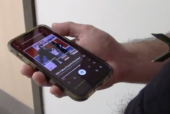Public school students in at least 40 schools of California’s 58 counties have been able to return to their classrooms for in-person instruction since the pandemic began.
However, those who remain online have faced several challenges. Some students have had limited access to devices, internet, meals. They’ve also faced Zoom fatigue caused by having to sit in front of a computer screen for several hours each day.
Juana Maria Valdivia, board president for a charter school network called PUC Schools, says the biggest challenge has been providing students with the technology needed to continue their education, and figuring out how to further support students with special needs.
“We’ve learned a lot of new things with this pandemic and I think it has brought us to where we are today,” Valdivia said. “As we started the first semester to be a little more structured and also the opportunity to provide more support to our students and engage more with the families through virtual meetings.”
PUC’ schools have been able to provide technology for their students, and have worked to provide more one-on-one interaction for students with special needs.
Valdivia said it’s crucial to understand that the pandemic is taking a toll on our mental health.
According to the Centers for Disease Control and Prevention (CDC), more children are going to the emergency room with mental health-related problems. The CDC said the proportion of emergency room visits by 12- to 17-year olds that involve mental health challenges increased 31% in 2020 compared to the previous year.
Lawrence King, superintendent of the Acton-Agua Dulce Unified School District, appreciates the work that administrators, teachers and classified school staff have done to create meaningful and engaging instructional methods for students and families.
The transition hasn’t been easy, King said, but “with continued training for teachers they have stepped up to learn all sorts of software.”.
In order to receive instruction, students need access to the internet through devices, hotspots and wi-fi..
A report published by the Economic Policy Institute concluded “the pandemic has exacerbated well-documented opportunity gaps that have put low-income students at a disadvantage relative to their better-off peers.”
“Those inequities start with technology,” Valdivia said. “We just learned that some families have three or four children and there’s one piece of technology and it had to be shared at some point.”
Students, teachers, administrators and educational leaders aren’t the only ones struggling with online learning. The move to distance learning has put parents in a tough position.
“I have a whole different level of respect for teachers,” said Porscha Chambers, a parent and college student, “because having to do the whole one-on-one with your child is like, ‘Wow!’ If parents have multiple children and they have to do this with each of them it’s a lot of work.”.
Keeping students engaged is a difficult task, especially for high school students as Zoom fatigue creeps in quickly.
By incorporating mindfulness into Friday lectures, PUC schools are finding ways to be more student centered and connect with them at a deeper level.
Acton-Agua Dulce Unified School District officials are relying on county health department guidance.
“We want to open up in a way that ensures safety for again not just students but also parents and visitors,” King said. “We’ve worked very closely with our teachers association, our California School Employees Association, our parents group to make sure that we are opening in a safe manner and again within the guidelines that have been implemented by the County of Department of Public Health. “
This story was produced by the following:
- Amanda Alvarado, moderator
- Savanna Birchfield, anchor
- Casey Contreras, reporter
- Kimberly Linares, reporter
- Sophia Lesseos, reporter

 Tweet this Video
Tweet this Video Share on Facebook
Share on Facebook Share via E-mail
Share via E-mail

